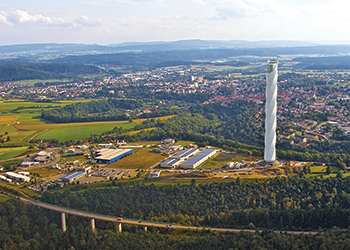
Thyssenkrupp has installed the first functional Multi at a 246-m-tall test tower in Rottweil, Germany.
Ropeless revolution
01 August 2017
Thyssenkrupp, one of the world’s leading elevator companies, has unveiled the first functional horizontal-vertical elevator system elevator system, Multi.
The world’s first ropeless and sideways-moving elevator system, Multi, was unveiled at the 246-m-tall test tower in Rottweil, Germany.
Instead of one cabin per shaft moving up and down, the Multi offers multiple cabins operating in loop, like a metro system inside a building. Without the use of cables, the system runs on a safe multi-level brake system and redundant wireless data and energy management on the cars, said the German industrial giant.
Commenting on the launch, Andreas Schierenbeck, the chief executive of thyssenkrupp Elevator, says: “We believe Multi is a genuine gamechanger that will truly transform the way people move, work and live in our built environment. It will reduce waiting times for passengers and take up significantly less space within the building.”
“Multi is a key offering that truly represents a landmark revolution in the elevator industry,” he says.
It requires fewer and smaller shafts than conventional elevators and can increase the building’s usable area by up to 25 per cent, representing extra revenues from the additional rentable/leasable space, explained Schierenbeck.
Schierenbeck says this is particularly important considering current elevator-escalator footprints can occupy up to 40 per cent of a high-rise building’s floor space, depending on the building height.
According to him, the leading European real estate business OVG Real Estate is Multi’s very first customer. In partnership with thyssenkrupp, various Multi systems will be installed in the new East Side Tower building in Berlin.
“We are absolutely delighted to partner with thyssenkrupp and to have the very first Multi installed in our latest project, The East Side Tower in Berlin,” says Coen van Oostrom. “The forward-thinking new technology that Multi brings to our flagship project, is a perfect fit for us.”
Experts point out that with cities continuing to grow and buildings getting larger and taller, planners and architects are facing significant challenges around moving people comfortably and quickly to their destinations.
Multi can achieve up to 50 per cent higher transport capacity and reduce peak power demand by as much as 60 per cent when compared to conventional elevator systems. These two factors mean a dramatic improvement for high-rise buildings, they state.
Additionally, since Multi can move sideways as well as vertically, and without any height limitations, it enables unprecedented possibilities in the architecture and design of buildings, they add.
According to experts, the Multi requires dramatically lower peak power, permitting a better management of the building’s energy needs, consequently reducing the investment costs in the power supply infrastructure.
On the novel system, Antony Wood, the executive director of the Council on Tall Buildings and Urban Habitat (CTBUH), says: “This is perhaps the biggest development in the elevator industry since the invention of the safety elevator some 165 years ago. The ‘holy grail’ for elevators has been to move beyond being pulled vertically by a rope under tension – towards a system that allows movement in inclined or horizontal directions.”
“Multi, more than any other product delivered to date, really shows the way forward for that potential. This has the capacity to transform the industry at large, changing the way tall buildings are designed, and allowing for much more efficient core designs, as well as better connectivity in buildings,” he concludes.


